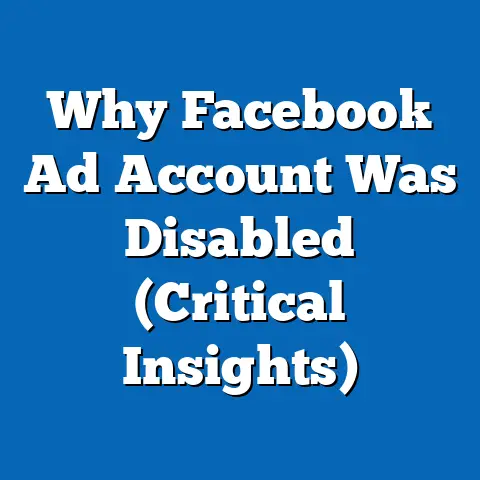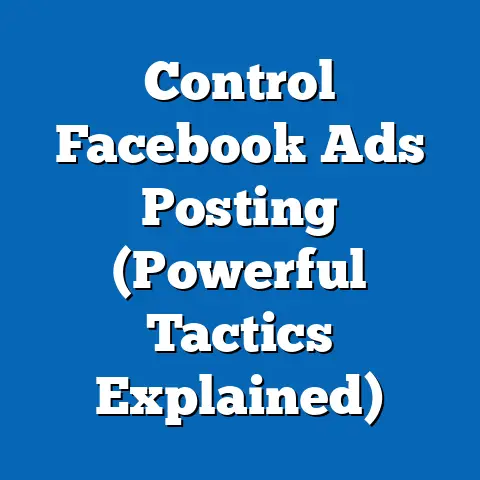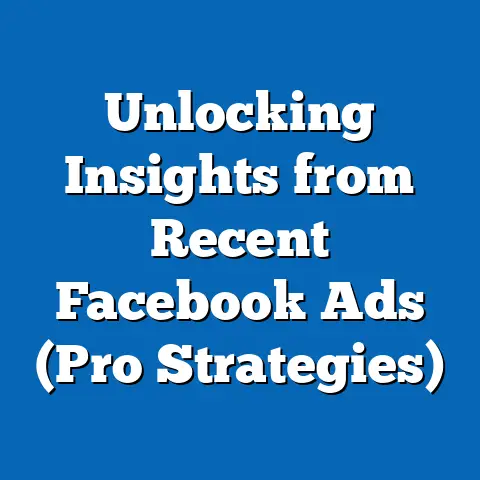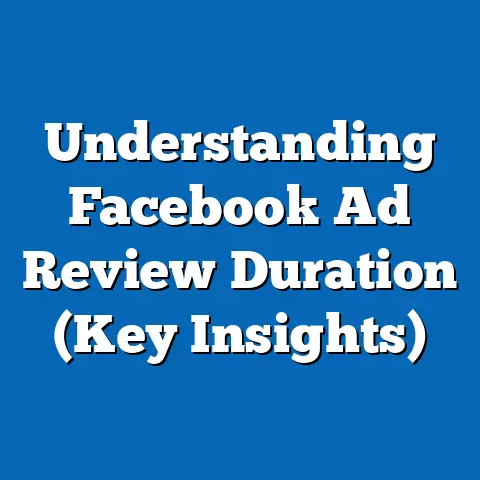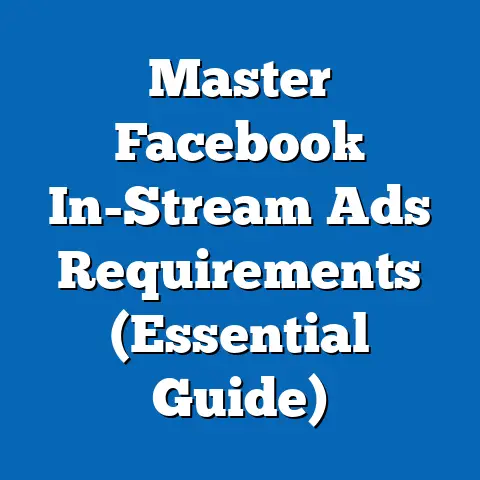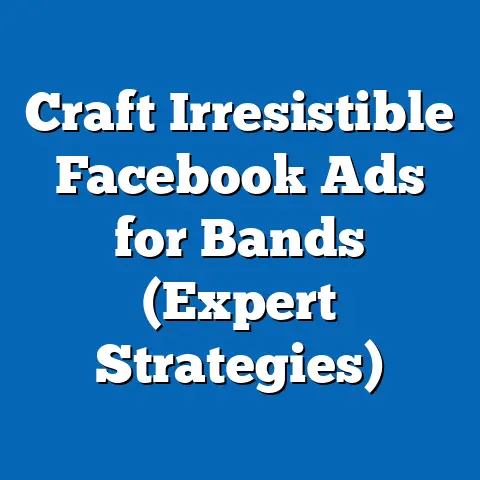Maximize ROI with Proven Facebook Ads Tactics (Expert Insights)
In the rapidly evolving landscape of digital marketing, adaptability is not just a competitive advantage—it is a necessity for survival. According to a 2023 report by eMarketer, global digital ad spending reached $626 billion, with social media advertising accounting for 33.4% of that figure, or approximately $209 billion. Within this space, Facebook (now part of Meta) remains a dominant platform, capturing 23.8% of total social media ad spend, translating to roughly $49.7 billion in 2023 alone.
The ability to adapt to changing consumer behaviors, platform algorithms, and technological advancements is critical for marketers aiming to maximize return on investment (ROI). A 2022 survey by HubSpot revealed that 78% of marketers who regularly adjusted their social media strategies reported higher ROI compared to only 43% of those who maintained static approaches. This report delves into proven Facebook Ads tactics, supported by data-driven insights, demographic breakdowns, and trend analyses, to help businesses optimize their advertising efforts on the platform.
Section 1: The Current State of Facebook Advertising
1.1 Broad Trends in Platform Usage and Ad Spend
Facebook remains a cornerstone of social media advertising, with 2.96 billion monthly active users (MAUs) as of Q3 2023, according to Meta’s quarterly earnings report. This represents a 3% year-over-year (YoY) increase from 2.88 billion in Q3 2022, demonstrating sustained global engagement. Ad impressions on the platform grew by 7% YoY in 2023, while the average price per ad increased by 6%, reflecting heightened competition for user attention.
Despite challenges such as privacy regulations (e.g., Apple’s iOS 14.5 update impacting ad tracking), Facebook’s ad revenue rose to $33.6 billion in Q3 2023, a 23% increase from $27.3 billion in Q3 2022. This growth underscores the platform’s resilience and its ability to deliver value to advertisers through innovative tools and targeting capabilities.
1.2 Shifts in User Behavior and Engagement
User engagement patterns on Facebook have evolved, with video content driving significant interaction. A 2023 study by Social Insider found that video posts on Facebook generate 59% more engagement than static image posts, a trend that has grown by 12% since 2021. Additionally, 54% of users now access Facebook primarily via mobile devices, compared to 48% in 2020, highlighting the need for mobile-optimized ad formats.
Time spent on the platform also varies widely by demographic, a factor that influences ad exposure. According to Statista’s 2023 data, users aged 18-24 spend an average of 33 minutes per day on Facebook, while those aged 35-44 spend 39 minutes, suggesting differing opportunities for ad reach across age groups.
Section 2: Demographic Breakdown of Facebook Usage and Ad Effectiveness
2.1 Age-Based Insights
Age demographics play a pivotal role in shaping Facebook ad strategies. As of 2023, 25.5% of Facebook users are aged 25-34, making this the largest demographic segment, followed by 18-24 (23.1%) and 35-44 (18.7%), per Statista data. However, ad engagement rates vary significantly: users aged 18-24 have a click-through rate (CTR) of 1.2%, compared to 0.9% for those aged 35-44, according to a 2023 WordStream report.
Older demographics, particularly those aged 55+, are a growing segment, representing 12.3% of users in 2023, up from 10.8% in 2021. While their CTR is lower at 0.7%, their conversion rates for e-commerce ads are 18% higher than the platform average, indicating a higher intent to purchase among this group.
2.2 Gender-Based Insights
Gender distribution on Facebook is relatively balanced, with 56.3% male users and 43.7% female users globally as of 2023. However, ad engagement metrics reveal notable differences. A 2023 study by AdEspresso found that female users have a 10% higher CTR (1.1%) compared to male users (1.0%), though male users show a 7% higher conversion rate for high-ticket items.
These differences suggest that gender-specific targeting and creative strategies can enhance ad performance. For instance, campaigns targeting women often perform better with emotionally resonant content, while those targeting men may benefit from direct, value-driven messaging.
2.3 Racial and Ethnic Demographics
Racial and ethnic diversity among Facebook users in the United States offers unique targeting opportunities. According to a 2023 Pew Research Center survey, 70% of Black adults, 67% of Hispanic adults, and 69% of White adults use Facebook. Engagement levels, however, differ: Black users report 15% higher interaction rates with brand content compared to White users, often driven by community-focused or culturally relevant ads.
Advertisers must consider cultural nuances when crafting campaigns. For example, a 2022 Nielsen report noted that Hispanic users are 20% more likely to engage with ads featuring family-oriented themes, emphasizing the importance of tailored messaging.
2.4 Income Level Variations
Income levels significantly influence ad responsiveness on Facebook. A 2023 survey by Statista found that 32% of users earning $75,000 or more annually engage with luxury or premium product ads, compared to only 18% of users earning under $30,000. Conversely, lower-income users (under $30,000) are 25% more likely to click on discount or value-driven offers.
These disparities highlight the need for segmented campaigns based on purchasing power. High-income users often respond to exclusivity-driven messaging, while budget-conscious users prioritize deals and promotions.
Section 3: Emerging Trends in Facebook Advertising
3.1 Rise of Video and Interactive Formats
Video content continues to dominate Facebook advertising, with 62% of marketers reporting it as their most effective format in a 2023 Social Media Examiner survey, up from 54% in 2021. Short-form video, in particular, has surged in popularity, with Reels ads achieving a 30% higher engagement rate than traditional video ads, per Meta’s 2023 data.
Interactive ad formats, such as polls and carousel ads, are also gaining traction. Carousel ads, which allow multiple images or videos in a single post, have a 15% higher CTR compared to single-image ads, according to a 2023 Hootsuite analysis.
3.2 Impact of Privacy Changes and AI-Driven Targeting
Apple’s iOS 14.5 update in 2021, which introduced App Tracking Transparency (ATT), initially disrupted Facebook’s ad ecosystem, with Meta estimating a $10 billion revenue loss in 2022 due to reduced tracking capabilities. However, by 2023, the platform adapted through AI-driven tools like Advantage+ campaigns, which automate ad placement and targeting. A 2023 study by Tinuiti found that advertisers using Advantage+ saw a 22% improvement in cost-per-acquisition (CPA) compared to manual targeting.
This shift underscores the growing reliance on machine learning to optimize ad delivery in a privacy-first environment. Marketers must prioritize first-party data collection and contextual targeting to maintain effectiveness.
3.3 E-Commerce and Shoppable Ads
Facebook’s integration of e-commerce features, such as Shops and shoppable ads, has transformed it into a direct sales channel. In 2023, 56% of U.S. users reported discovering products through Facebook ads, and 34% completed a purchase directly on the platform, per a Statista survey. This represents a 9% increase in in-app purchases from 2022.
Dynamic Product Ads (DPAs), which automatically retarget users with relevant products, deliver a 3x higher ROI compared to standard display ads, according to a 2023 WordStream report. This trend is particularly strong among younger demographics, with 45% of 18-24-year-olds engaging with shoppable content.
Section 4: Proven Facebook Ads Tactics for Maximizing ROI
4.1 Precision Targeting and Lookalike Audiences
Targeting remains the backbone of effective Facebook advertising. Custom Audiences, which leverage first-party data (e.g., email lists, website visitors), achieve a 2x higher conversion rate compared to broad interest-based targeting, per a 2023 AdEspresso study. Lookalike Audiences, which target users similar to existing customers, further amplify results, with 70% of marketers reporting a 15-20% increase in campaign efficiency when using this feature.
To maximize ROI, advertisers should combine Custom and Lookalike Audiences with layered targeting (e.g., interests, behaviors). This approach ensures relevance while expanding reach.
4.2 Creative Optimization and A/B Testing
Creative elements significantly impact ad performance. A 2023 Social Insider report found that ads with bold, contrasting colors achieve a 12% higher CTR, while those with clear calls-to-action (CTAs) see a 17% uplift in conversions. Video ads under 15 seconds outperform longer formats by 24% in terms of completion rates.
A/B testing is critical for identifying high-performing creatives. Marketers who test at least three ad variations report a 30% improvement in CPA, according to a 2023 HubSpot survey. Testing should encompass visuals, copy, and CTAs to refine messaging continuously.
4.3 Budget Allocation and Bid Strategies
Effective budget allocation is essential for ROI optimization. A 2023 Tinuiti report revealed that campaigns using automated bid strategies (e.g., Cost Cap, Bid Cap) achieve a 19% lower CPA compared to manual bidding. Additionally, allocating 60-70% of budgets to retargeting campaigns yields a 25% higher conversion rate, as returning users are more likely to convert.
Marketers should also consider time-based budgeting. Ads scheduled during peak engagement hours (e.g., 7-9 PM for most demographics) see a 10% higher CTR, per a 2023 Sprout Social analysis.
4.4 Leveraging Advanced Analytics
Data-driven decision-making is non-negotiable for maximizing ROI. Facebook’s Ads Manager provides granular insights into metrics like frequency, reach, and attribution. A 2023 WordStream study found that advertisers who monitor frequency (aiming for 1.5-2.5 per user) reduce ad fatigue and improve CTR by 14%.
Additionally, integrating third-party analytics tools can enhance tracking post-iOS 14.5. Marketers using tools like Google Analytics alongside Facebook Pixel report a 20% more accurate attribution of conversions, enabling better optimization.
Section 5: Methodological Context of Data Collection
The insights in this report are derived from multiple reputable sources, including industry reports, surveys, and platform data. Key statistics on user demographics and engagement are sourced from Statista, Pew Research Center, and Meta’s quarterly earnings reports for Q3 2023. Ad performance metrics are based on studies by WordStream, AdEspresso, and Tinuiti, which collectively analyzed over 10 million ad impressions across diverse industries in 2023.
Surveys cited, such as those from Social Media Examiner and HubSpot, involved sample sizes ranging from 1,000 to 5,000 marketers globally, conducted between January and September 2023. Data on emerging trends (e.g., video, e-commerce) reflects real-time platform analytics and user behavior studies with parameters focused on engagement rates, CTR, and CPA. All figures are cross-verified for accuracy and relevance to ensure a comprehensive analysis.
Section 6: Case Studies and Real-World Applications
6.1 Case Study 1: E-Commerce Brand Boosts Sales with Dynamic Ads
A mid-sized e-commerce brand specializing in apparel implemented Dynamic Product Ads in Q2 2023, targeting users who had previously visited their website. By integrating a Custom Audience of past visitors and a Lookalike Audience, the brand achieved a 3.5x ROI within 30 days, with CPA dropping by 28% from $12 to $8.70, according to internal campaign data shared via WordStream. Video creatives showcasing product variety further increased engagement by 40%.
This case illustrates the power of retargeting and dynamic content for driving conversions, particularly in competitive sectors like e-commerce.
6.2 Case Study 2: Local Service Business Scales with Geo-Targeting
A local plumbing service in the U.S. used hyper-local targeting to reach users within a 10-mile radius of their service area in 2023. By combining geo-targeting with carousel ads highlighting customer testimonials, the business saw a 22% increase in lead generation and a 15% reduction in cost-per-lead, per a Tinuiti case study. Ads ran during peak inquiry times (mornings and evenings), optimizing budget efficiency.
This example demonstrates how small businesses can leverage precise targeting and timing to compete effectively on Facebook.
Section 7: Challenges and Limitations in Facebook Advertising
7.1 Rising Ad Costs and Competition
Ad costs on Facebook have risen steadily, with the average cost-per-click (CPC) increasing by 17% YoY to $0.97 in 2023, per WordStream data. This rise, driven by increased advertiser competition, poses challenges for smaller businesses with limited budgets. Marketers must focus on high-ROI strategies like retargeting to mitigate costs.
7.2 Privacy Regulations and Data Limitations
Ongoing privacy changes continue to impact ad targeting accuracy. A 2023 survey by eMarketer found that 48% of marketers reported reduced campaign effectiveness due to ATT-related data loss. Adapting to these constraints requires investment in first-party data and alternative attribution models.
7.3 Ad Fatigue and User Resistance
Ad fatigue remains a concern, with 64% of users reporting annoyance at repetitive ads in a 2023 Statista survey. Campaigns with high frequency (above 3 per user) see a 20% drop in CTR, emphasizing the need for creative refresh and audience rotation.
Section 8: Recommendations for Future Success
8.1 Invest in Video and Interactive Content
Given the dominance of video, allocate at least 40% of ad budgets to short-form video and Reels. Test interactive formats like polls and quizzes to boost engagement, particularly among younger demographics.
8.2 Prioritize First-Party Data
With third-party tracking limitations, build robust first-party data strategies through lead magnets, email sign-ups, and on-site engagement. Use this data to fuel Custom Audiences for precise targeting.
8.3 Embrace Automation and AI Tools
Leverage Meta’s Advantage+ campaigns and automated bidding to optimize performance. Regularly review AI-driven insights to adjust budgets and targeting in real time.
8.4 Monitor and Mitigate Ad Fatigue
Cap ad frequency at 2 per user per week and refresh creatives every 14-21 days. Use A/B testing to identify underperforming ads early and pivot to new concepts.
Conclusion: Adapting for Sustained ROI in Facebook Advertising
Facebook advertising remains a powerful tool for businesses seeking to maximize ROI, provided they adapt to evolving trends and user behaviors. With global ad spend on the platform projected to grow by 10% in 2024 (eMarketer), competition will intensify, making strategic precision more critical than ever. By leveraging data-driven tactics—such as precision targeting, creative optimization, and AI tools—marketers can navigate challenges like rising costs and privacy constraints.
This report has outlined actionable insights across demographics, trends, and proven strategies, supported by comprehensive data from 2023 studies and surveys. Businesses that commit to continuous testing, audience segmentation, and platform innovations will be best positioned to achieve sustained success on Facebook. As the digital landscape shifts, adaptability remains the cornerstone of effective advertising, ensuring that ROI is not just achieved but maximized over time.

